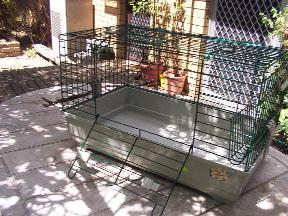
HOUSING - Nikki White
Indoor Cavies
Cavies work well inside a house. You don't have to worry about extremes of temperature, stray cats or dogs and you get much more pleasure having them where you can see them and their antics all the time, and you can interact with them. They don't smell if cleaned regularly, they are easy and cheap to feed. They don't need any vaccinations and are hardy as long as they are kept out of direct sunlight, extreme heat and damp. They make good companions for people living alone, who lead busy lives, who lives in flats or older people (Pets 'n People no. 21 (2001) had a witty and informative article on how they are the perfect pet for such folk). They are easy to handle for those whose age or injuries make having a cat or dog out of the question. They are responsive and greet you with squeaks and chirps, they purr when stroked and they have a wide repertoire of sounds including mutterings and chatterings to themselves. You are never alone with a guinea pig. They have a nice solid shape and feel good to hold, too.
Indoor cavies make wonderful garbage disposal/recycling units
. If you have fresh vegetables left over after chopping up what you need for cooking, these will always find a good home with your indoor cavies. All donations gratefully received. You can talk to them and they will talk back. You can take them out and sit with them on your lap - they like to snuggle in when you stroke them on their foreheads, cheeks or nape of the neck and they purr.It is best to have at least two cavies as they are herd animals and don't much like to be alone. Either two sows (females) or two boars (males). Boars can live together as long as there are no sows about. The only other animals near my indoor cavies are two rabbits, both bucks (males) and the female cats are spayed. A young boar put with an older boar (often his father) works well, or two brothers brought up together.
I do not recommend free-range cavies loose in the house, especially without a cage. There are too many places for them to hide, get squashed, trampled on, or chew things like electric wires. They can be very hard to catch as they can be surprisingly fast and their coats (except for Rex and Abyssinians) are sleek and slippery. My mother spent hours trying to retrieve Dumpling, her Chocolate Satin Himalayan boar, who had escaped the kitchen and hidden in parts of the lounge-room and she lives in only a small flat. She only caught him with my brother's help. Besides, if they live on the floor in a modern Australian kitchen (as opposed to one in the Andes), they are not getting their nutrition, they can't forage around for food, nibble and gnaw their teeth down as they can inside a cage.
You can purchase indoor cages of various sizes from pet shops. These have plastic bases with high sides and a metal wire top with a door in the side and a lid on top. Do not buy those which have a clear plastic top as they do not allow sufficient air circulation in our hot climate.
These cages cost from $99 (smallest) to over $200 for the largest.

Smallest cage is 60cm long x 35 cm deep x 38cm high and is suitable for one cavy. It comes with a hayrack and a water bottle.

Medium cage is suitable for two cavies. It is 70cm long x 40 cm deep x 38 cam high. It also comes with a hayrack and water bottle.
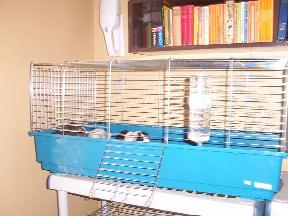
Large cage is suitable for three to four cavies. It is 95 cm long x 50 cam deep x 45 cm high and comes with a water bottle and hayrack.
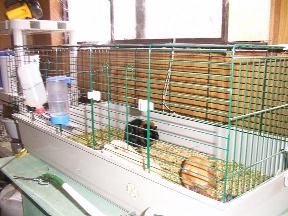
Largest cage is suitable for four or more cavies. It is 117 cm long x 55 cm deep x 51 cm high and comes with hayrack and water bottle.
A cage can be put on a stand so that it is at chest level which saves a lot of bending down. Those three or four tier plastic self-assembly units available at hardware stores such as Bunnings are ideal (the medium cage is resting on a lower shelf of one and one can be seen under the large blue cage and another beside the largest cage). They are light, can be easily moved and cleaned, are sturdy and stable. The shelves can be adjusted to take two cages one on top of the other leaving a narrow shelf at the bottom for storing food bins.
The cage should be lined with old newspaper (broadsheets, i.e. something the size of the Canberra Times or the Sydney Morning Herald are just right for the medium cages). On top goes an absorbent litter. This can be either compacted rice hulls (made by Coprice and available from most stockfeed merchants) or wood shavings (available from most stockfeed merchants, pet shops or some supermarkets).Then on top of this some sort of hay, meadow hay or lucerne. Or you could put some of this in the hayrack. Straw can also be used if hay is not available as is often the case during drought. This gives the cavies something to browse and nibble at as well as supplying roughage and wearing their teeth down.
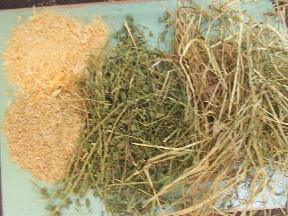
Top left: Sawdust; Bottom left: Rice hulls. Middle: Lucerne hay; Right: Meadow hay
The cage needs to be cleaned out once a week. Put the cavies in a box or an exercise pen (my mother uses a large empty flower pot which allows Dumpling to sit up and peer over the top to see what's going on). Roll the newspaper and bedding up and either put the sawdust/rice hulls and hay/straw on the compost heap and the newspaper in the rubbish bin (in Canberra's dry climate the newspaper just dries up and blows around the garden unlike say, Sydney, where they get enough rain to break it down), or else, if you don't have a garden put the whole lot in the bin.
Sluice out the plastic base of the cage (the metal top is removable), scour out any urine crystal deposits in the corners with cleaning vinegar (white vinegar) and a steel cleaning pad. Dry and refill. It takes very little time.
Food should be in ceramic dishes which can't be easily kicked over. Small ramekins which cost around $2 from supermarkets or small rabbit feed dishes from most pet shops are ideal. You can also get ceramic double bowls for cavies, rabbits or cats. They are all the same, only the animal painted on them changes. They are useful when you have a couple of cavies together. Hayracks keep the hay from getting soiled and make the cavies work for their food by having to reach up. Dumpling likes to snuggle under the rack when he wants to feel secure and watch the world go by.
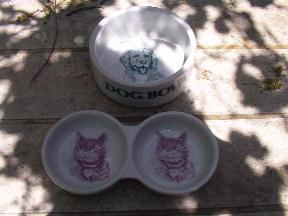
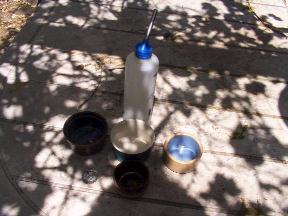
Water
should be given in plastic gravity bottles not dishes as it can become soiled or contaminated when the cavy kicks sawdust, food, etc. into it while running about. These should be cleaned out at least weekly with a bottle brush and hot water as food gets caught in them and they get scummy. Algae can grow in them too. You can either buy a gravity bottle complete from a pet shop or stockfeed merchant or simply the spout which can be screwed on to the top of many soft drink bottles such as Sprite or Coca Cola. They then attach to the cage with wire.
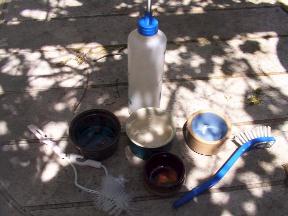
Outdoor cavies
Outdoor hutches suitable for cavies can be bought at stockfeed merchants or pet shops. There are two types. One type is wooden with an enclosed sleeping area, and small gauge aviary wire sides and base in the run area. Access is gained through a side door with a bolt or by lifting up the lid of the enclosed area. The other type is metal with an enclosed sleeping area with a lid which lifts up and fastens with a hook, and a sliding door in the run area. Both sit flat on the ground. Both cost about the same. There are advantages and disadvantages to both types.
Wood: Advantage is that it keeps the cavies warm in winter. The disadvantages are that it can be difficult to clean and get dry (painting with an acrylic-based outdoor paint like Dulux Weathershield, for example, should prevent problems with urine soaking the wood and damp from the ground warping the base); cavies can also gnaw and destroy wood (though they are not as bad as rabbits).
Metal: Advantages are that it is easily cleaned as it can be blasted with a hose and given the old vinegar treatment for urine crystals and it will dry quickly; it isn't susceptible to damp and can't be chewed. Disadvantages are that it can be hot in summer and cold in winter. Lots of bedding, newspapers or other cavies will help with the cold (I had a pair of sows who happily got through minus 9 winters in a metal hutch) and a soaker hose set low on the roof helps in extreme heat.
Besides these, there is home-made accommodation. Staying with single tier hutches, you can convert a child's wooden playpen by putting aviary wire around the inside, attaching it to the pillars with tie-wire, and on the bottom of the pen. Put in a plastic box with a lid and hole cut in the side for a sleeping area and cover the pen with a secure 'lid' - either a lattice or a frame with wire.
If you have a number of cavies, more than can be easily accommodated in one of these outdoor cages, you can go for a multi-storey home. A converted wardrobe is cheapest. You can get an old wardrobe from Revolve. You take out any extraneous shelves so you can fit shelves that run its width. These should be about 45cm apart. The wardrobe doors can be replaced with wire ones which are securely fastened to keep out predators yet allow the cavies to breath when shut.
Multi-tier cages can sometimes be had from NSW Cavy Club shows, particularly the Christmas Party and Show at Pymble (Kuring-gai Town Hall). or you can make your own from scratch. A number of cavy books have drawings or photos, for example, Gurney, Peter, Guinea Pig. London, HarperCollins, 1999. ISBN 0004133889; Day, Isabel, Hamlyn Pet Care Handbooks: Guinea Pigs. London, Hamlyn, 1987. ISBN 0600551407; Evans, Mark, How to Look After Your Pet: Guinea Pigs. Sydney, Angus & Robertson, 1992. ISBN 0207176558; Henwood, Chris, Pet Owner's Guide to the Guinea Pig. Lydney, Ringpress Books, 1999 ISBN 1860541100; Page, Gill. Getting To Know Your Guinea Pig. Dorking, Surrey, Interpet Books, 2000. ISBN 1903098149.
The cages should be filled with newspaper, rice hulls/wood shavings and hay/straw, plus water bottle and ceramic bowls as for indoor cages. They should also be cleaned out once a week, using the same procedure except that it is better to spray the wooden parts with a disinfectant and wipe it dry rather than blast it with a hose otherwise it will take too long to dry. A paint scraper is a good idea for removing soggy bits trapped in corners and for scraping anything thing stuck to the bottom though with newspapers this shouldn't occur. Any hay/straw or rice hulls/wood shavings left loose after the newspaper has been bundled up can be swept out with a pan and brush.
You can have multi-tier cages in sheds. Most breeders do this. These are usually purpose built but are furnished as for any other cage and are maintained in the same way.
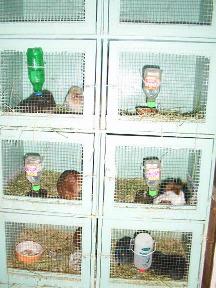
Whatever you choose, the cages should be sturdy to keep out stray cats and dogs. They should be weather-proof (multi-tiers should have a projecting roof to keep the rain off and all wooden cages should be painted with an outdoor acrylic-based paint). They should be in a sheltered spot away from direct sun or wind. Preferably they should be moveable so they can be relocated in extreme temperatures. It is a good idea to cover them with flyscreen wire as this gives added protection from prying paws and keeps out annoying insects. Unlike rabbits, cavies are not prone to diseases carried by flying insects but mosquitoes and flies can be irritating.
Cavies are hardy little creatures but they do not tolerate heat well. They come from the Andes mountains originally and prefer a cooler climate. As I've mentioned, mine tolerate sub-zero temperatures well. However, direct spring or summer sun is often fatal even if it doesn't appear to be a particularly hot day. It seems to have something to do with the angle the sun falls on the cavy, if they are directly in the rays, they can develop heat-stroke rapidly and unlike rabbits do not seem to recover as well, even after being cooled. I have lost two cavies on two separate occasions this way. They were at an agricultural display in a shed. The morning sun comes in through the door and is quite fierce even though the day is not particularly hot. In one case, the cavy had been spritzed with water and covered over. The cavies on either side (one of which was a long-haired breed, the Texel) were not affected as they were not directly in the line of the sun's rays.
So they must be kept out of direct sun. Their water should be cool or they may not drink it if it gets warm and could even die of thirst. Ice cubes in the water bottle help on really hot days. Cavies can be kept cool by placing a wet towel over the hutch, or leaving a frozen water bottle for them to lie against or a soaker hose set low placed across the roof (in times of water restrictions, a hand held hose can be played over the hutch to bring the temperature down.
The single tier hutches which rest on the ground can be moved around the garden so the cavies can mow your lawn at the same time as they fertilise it. In summer time they can be moved under trees or shrubs to provide shade.
Exercise pens can be made for indoor cavies to enjoy the outdoors while you clean their cages. These can be very simple. One method is to get two pieces of garden lattice (180 cm x 90 cm) and either aviary wire or two smaller pieces of lattice (90 cm x 90 cm) at each end, secured with tie wire, then put dividers or aviary wire within. This is useful for boars who are not housed together. Otherwise a child's playpen as described earlier but minus the sleeping box, or a child's cot turned upside down with the legs sawn off and aviary wire around the inside and on the base. These give indoor cavies a chance to graze and enjoy the fresh air. The NSW Cavy Club is selling off its old show cages which were used at agricultural shows and these make good lawn cages. They are in banks of three and made of heavy gauge aviary wire. They rest directly on the ground so the cavies, who are separated b y wire dividers, can graze on the grass. These are good for boars who don't run together. Another useful lAwn cage can be made from simply placing a cavy or two under the detachable wire top of an indoor cage.
.